To learn how to hunt bobcats, you need to take three steps to answer three crucial questions. First, where will I find a bobcat? Second, how should I set up my bobcat shooting location? Third, what calls and sequences should I use to bring the bobcats in close? You’ll find the answers to all those questions in this article.
Hunting bobcats takes three steps: 1. Find where they live. 2. Pick the right locations and use the correct setups. 3. Know what calls bobcats respond to and use the proper sequences.
Related: Read about the one bobcat calling tip to help you beat a bobcat’s camouflage.
Related: The best time to hunt bobcats.
How to hunt bobcats: Step #1 Finding where they live.
You have to hunt bobcats in their backyard. To do that, you’ll need to identify the habitat they prefer, scout areas providing that habitat, and confirm bobcats are using it by finding signs (scat and tracks).
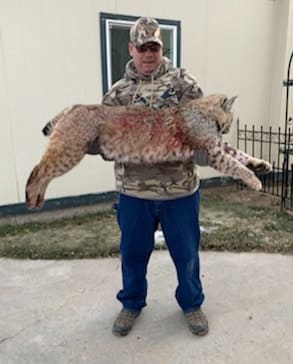
Adam Fackelman’s secret to taking a monster 37 lbs bobcat like this one?
“I shoot heavy-caliber bullets for coyotes and Bobcats as it doesn’t tear up the hides as bad. I like using the Primos Catnip call; it works well for Bobcats. I also use the Lucky Duck Revolt electronic call.”
“I always find cats in really brushy draws or big cut banks that are pretty deep. Many people say cats take a long time to come to calls, but if you set up close to these deep cover, big draws, or rocky outcroppings, I have found they come in as fast as most coyotes.”
“The key with any predator calling is sitting still and just moving your eyes and scanning for incoming predators.”
Bobcat hunting begins with identifying their preferred habitat.
While bobcats live throughout the continental United States and parts of southern Canada and northern Mexico, they reside only where these areas have the perfect “habitat.” As we’ve seen in this article, that habitat is often called “rabbit-tat” by coyote hunters.
Rabbit-tat is where rabbits live. Dense brushy areas, riverbanks bordered with heavy vegetation, land cleared of trees, places where the tree line of a forest meets a farm field. Rabbits, rodents, and insects find the security of cover here, as well as plenty of food and water. All three make up a large part of the bobcat’s diet.
Bobcat habitat also provides excellent concealment for a stalking feline. Such habitat allows the bobcat to spend its day unseen as it scouts and stalks the land. While it does so, it will hear and see everything yet remain nearly invisible and deathly silent.
Once you find suitable habitat, now you must confirm that bobcats are in the area by finding their scat and tracks.
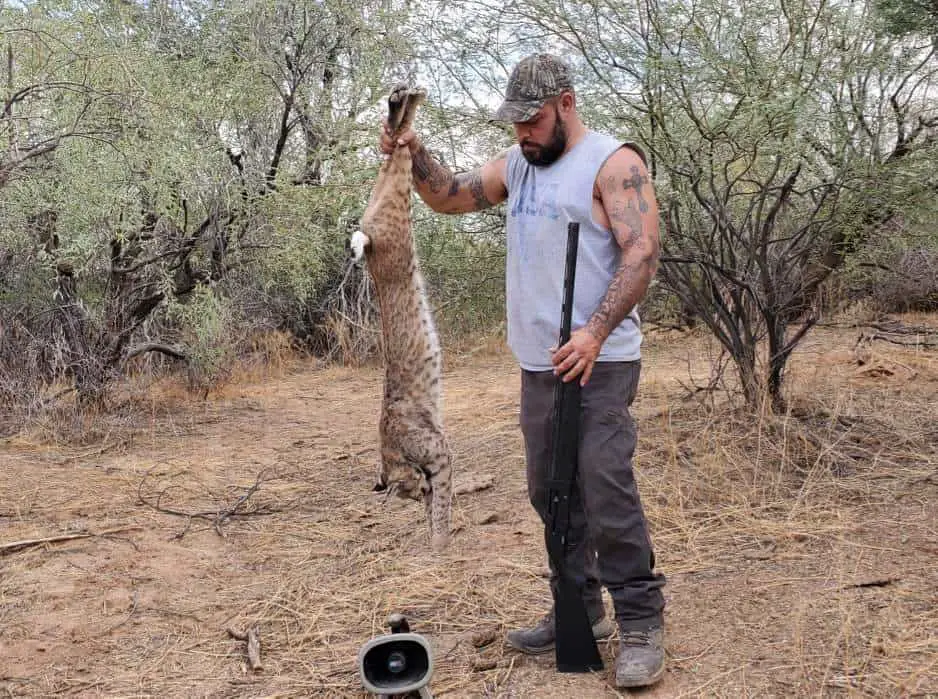

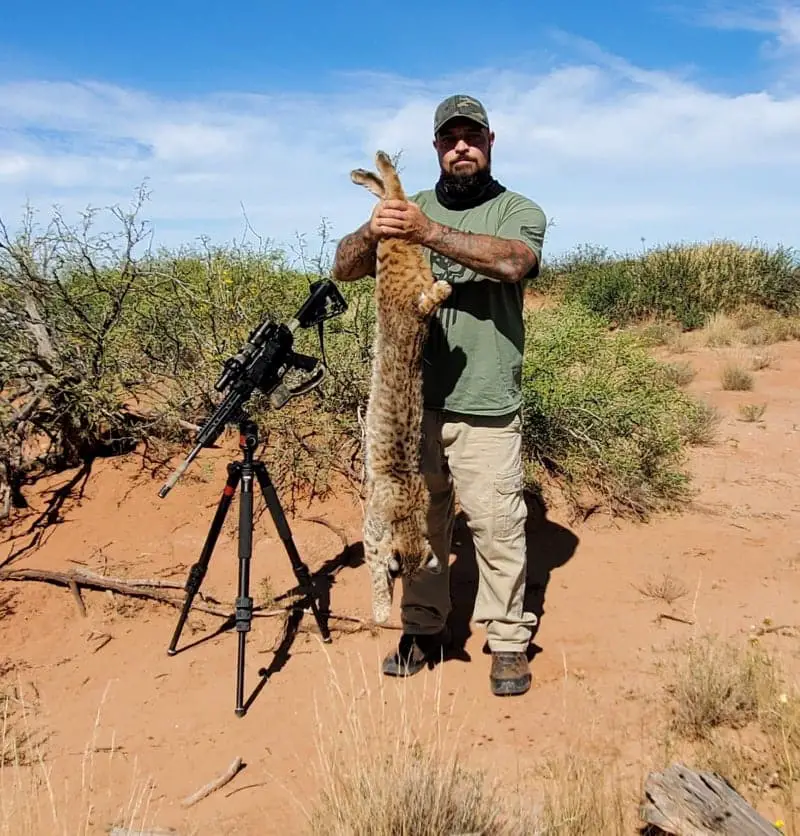
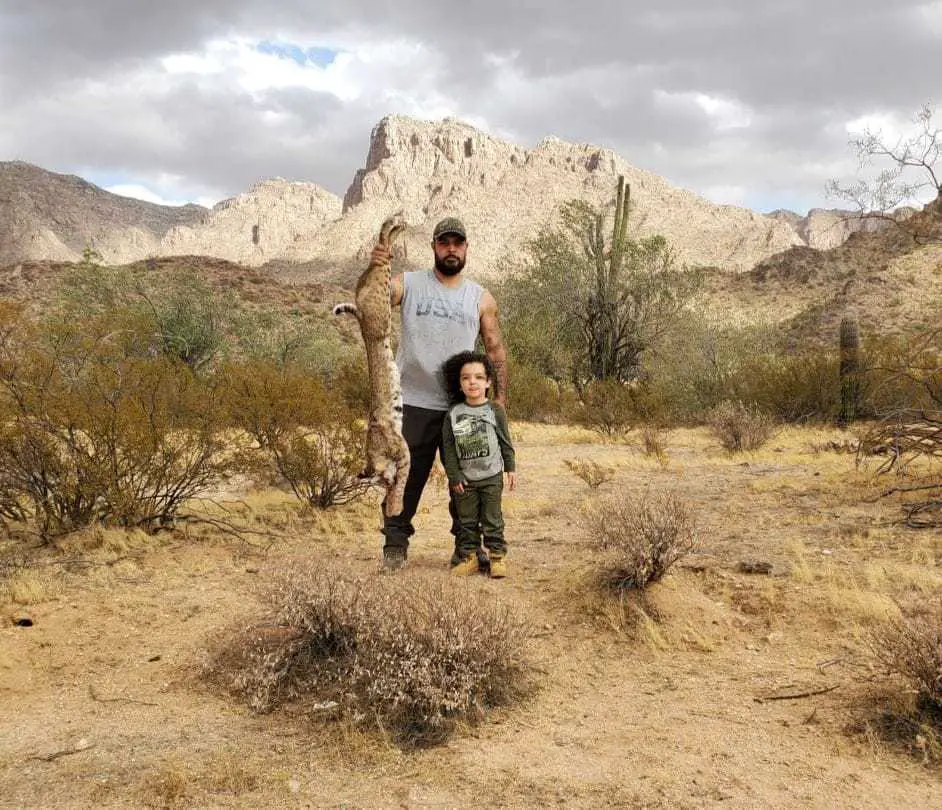
Andy Fraga’s tips for luring in bobcat after bobcat in Arizona?
“I like using high-pitched distress sounds for bobcats. I keep my caller going nonstop on the stand. I look for busy, fast-paced sounds when choosing a sound to play for bobcats. Most cats respond to baby cottontail or bird sounds.”
“It helps to have a moving decoy to keep attention off yourself when calling. I sometimes use a single feather on a string tied to a branch that will move in the wind.”
Bobcat hunting mistake: Not finding sign and wasting your time.
Bobcat sign is so important that I dare say, ignore even the best habitat if you cannot find bobcat tracks our scat. The area may be a perfect place for them to live, but there are no bobcats there if there’s no sign.
Once you have found the perfect habitat, find as many other nearby locations as you can. Aim to have several stand locations at least ½ mile apart. The more stands you have, the better your odds of seeing a bobcat.
Related: How-to-read-bobcat-prints-and-scat.
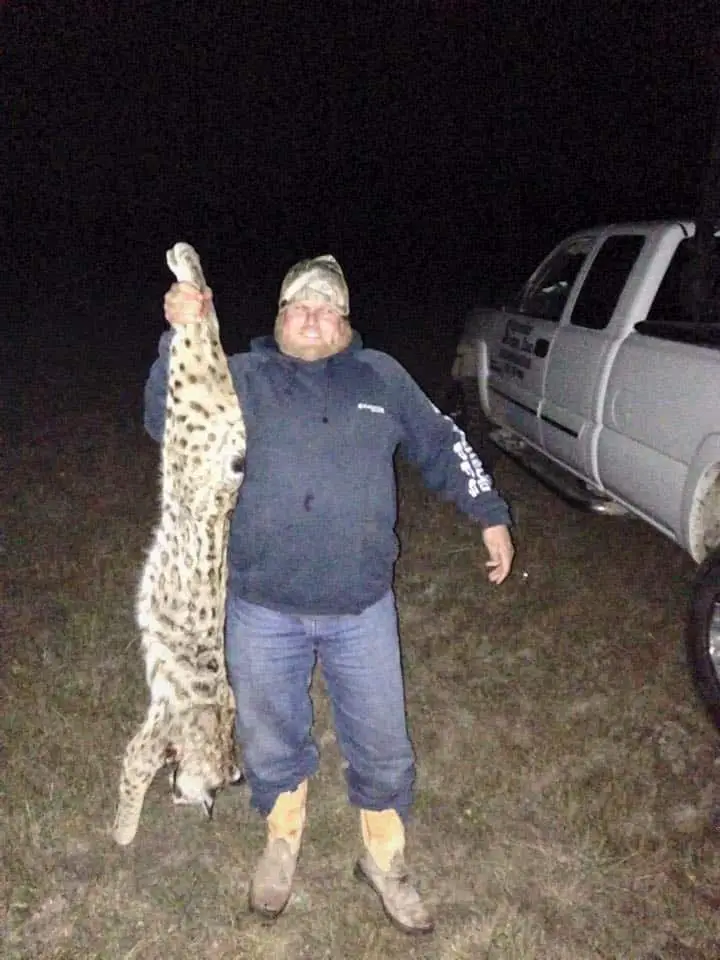
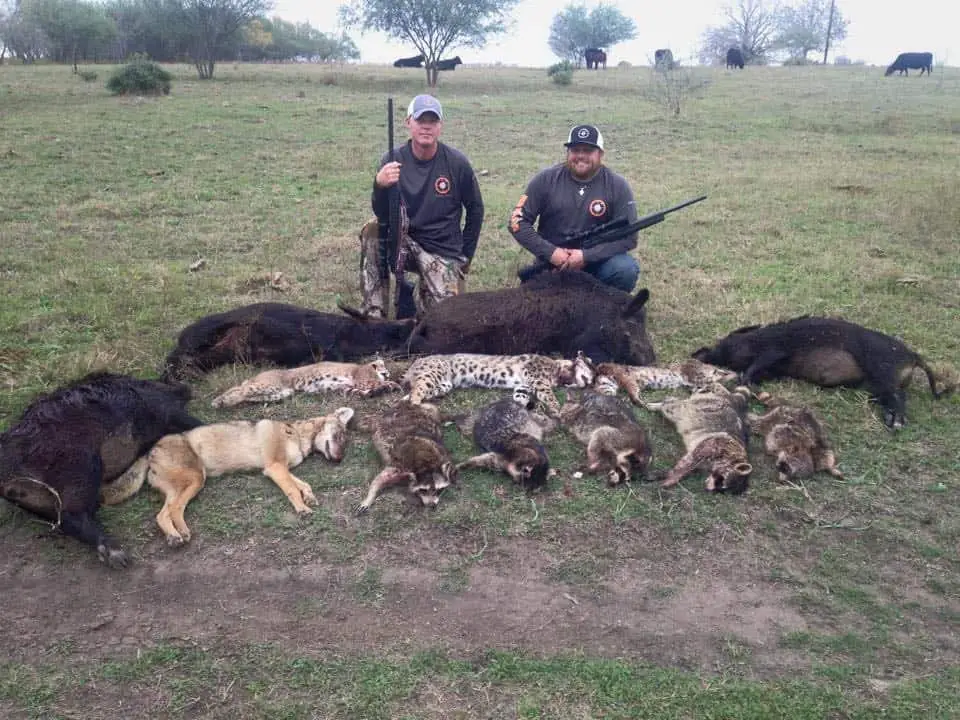
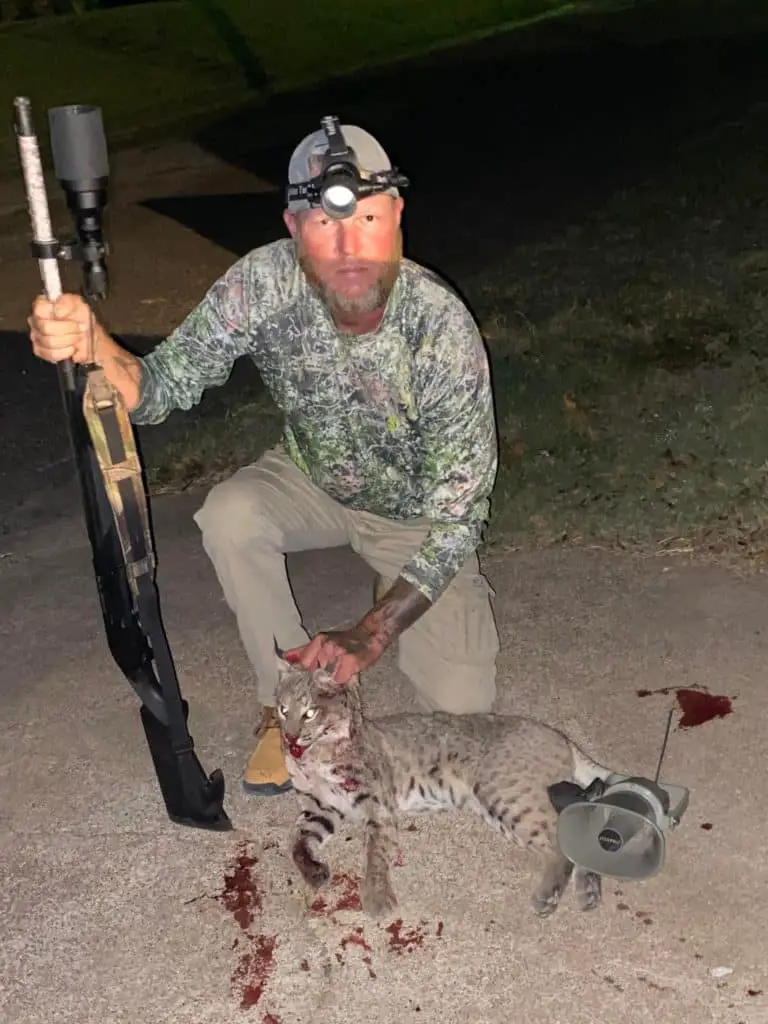
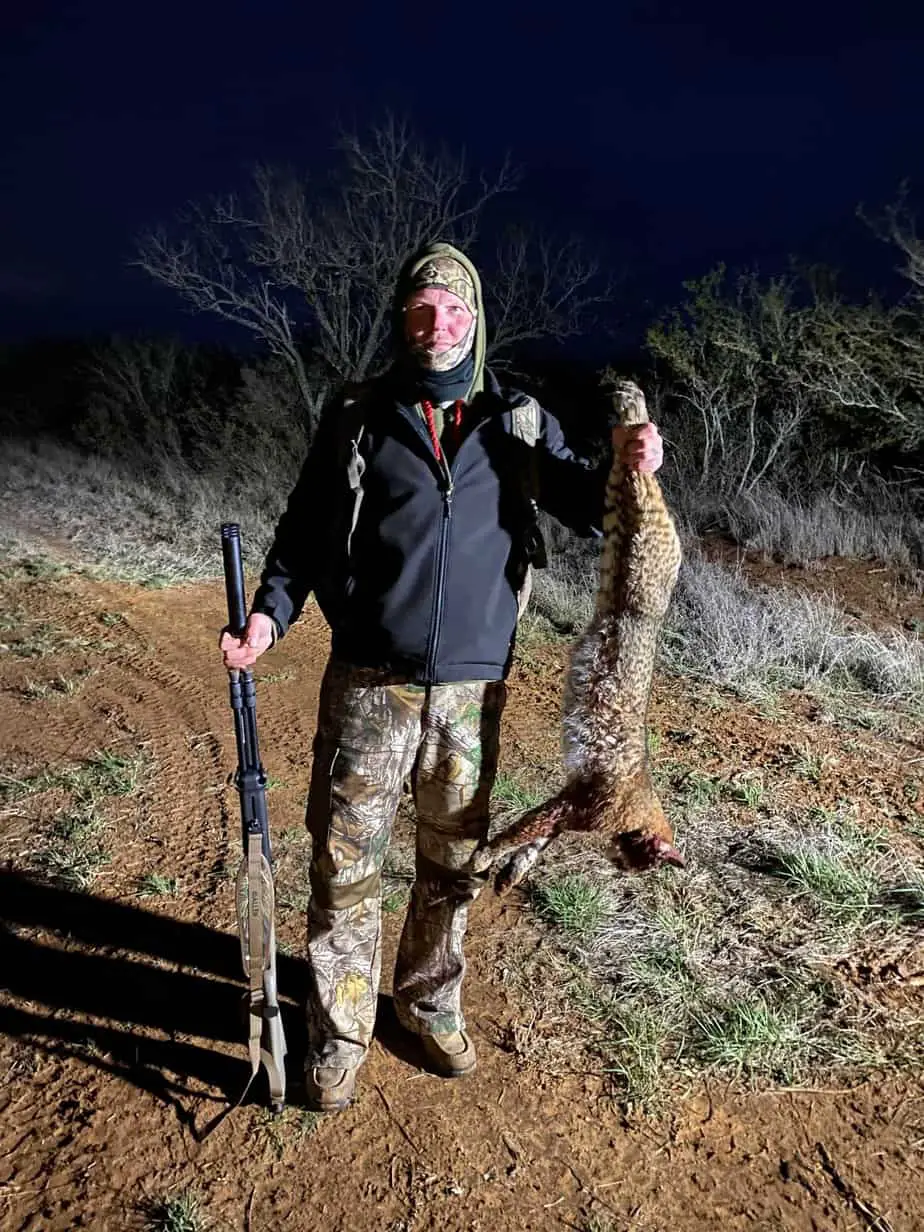
Bobcat hunting Step #2: Setups and locations.
Given the bobcat’s natural camouflage and the habitat it resides in, you should understand one thing: you will have a bobcat suddenly appear a mere few yards away from you. No matter how well you scan, one will sneak in undetected until the last second.
It happens all the time. You start calling that thick brush and continuously scanning the area ahead of you, never for a second lowering your guard, and then BOOM—you catch sight of a bobcat 15 yards away staring straight at you.
Bobcat Hunting Pro Tip: Unlike any other predator, a bobcat will freeze momentarily upon being discovered. Be ready to shoot from the moment you begin calling until after you have stood up to leave—but be prepared to take a second shot if you miss and the cat freezes in place.
Watch this video of a female bobcat (with kittens) reacting to be detected by a human a few yards away. Her withdrawal is so slow, and it almost looks like she is caught in a foothold trap.
Thanks to https://www.facebook.com/overdriveoutdoors/ for the above video.
Bobcat hunting with a caller and a decoy.
If you are hunting during the day, you’ll need a decoy. During the day, you want that sight-hunting bobcat to focus solely on your lure. This helps you remain unseen as the cat stalks into range and sits and studies the area around it.
Either way, both the decoy and the caller should be at least 25 yards ahead of you.



Pat Lageman’s set explained:
“I took these photos in 2011 in Christian County, Kentucky. Using a Mossberg 835 12 gauge with Hevi-shot Dead Coyote T-shot, I called this 21-pound female bobcat within thirty-five yards.”
“I also used a Foxpro 416B e-caller (woodpecker sounds) and a Whirlin Woodpecker decoy.”
Stand up when you hunt bobcat in thick terrain.
With the wind in your face and a tree at your back to break up your human form, clear out a space for your feet to move around in. You are going to be here for a long time. Make sure you can shift your weight, move your feet around, and lean against a tree to maintain some level of comfort.
Bobcat hunting pro tip:
Sit in front of trees and bushes, never behind or within them. If you aren’t in front, you’ll be fighting target blocking branches and twigs and won’t have a clear shot at all times.
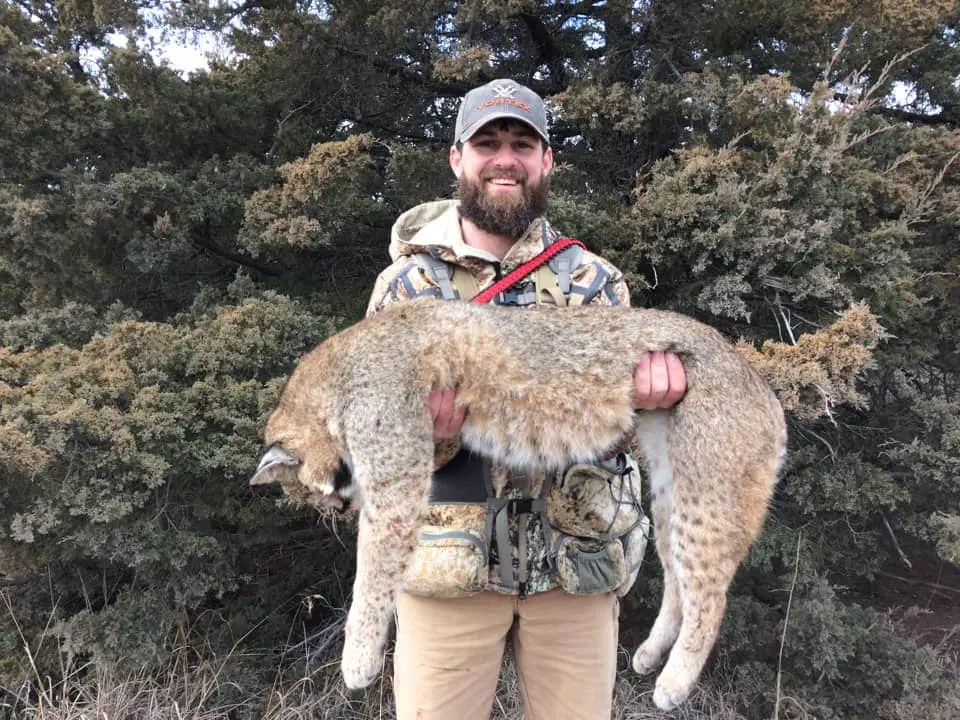
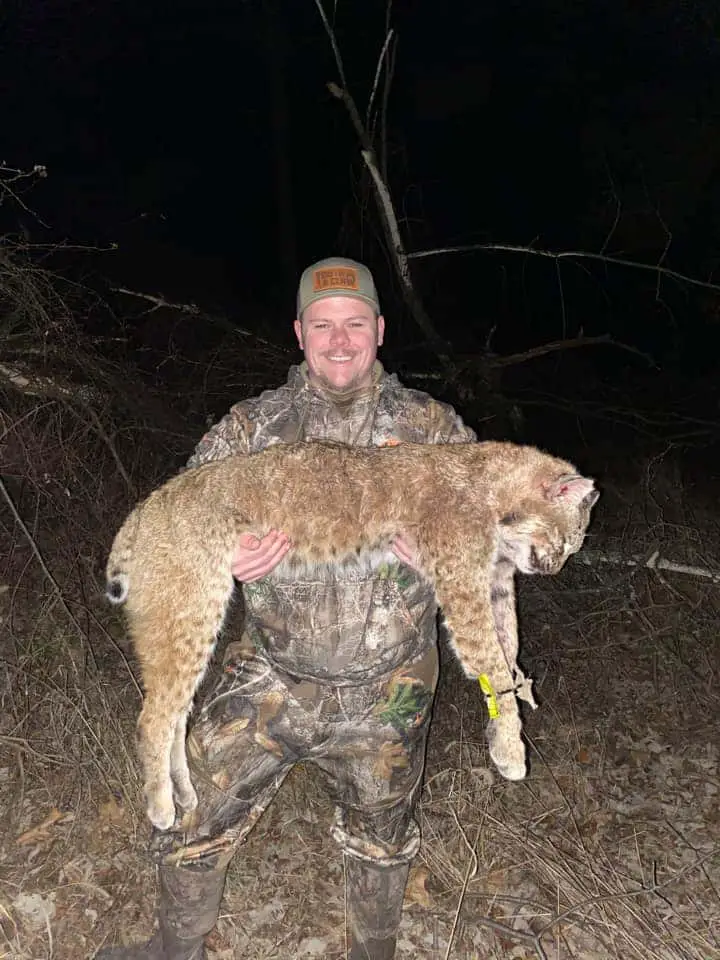
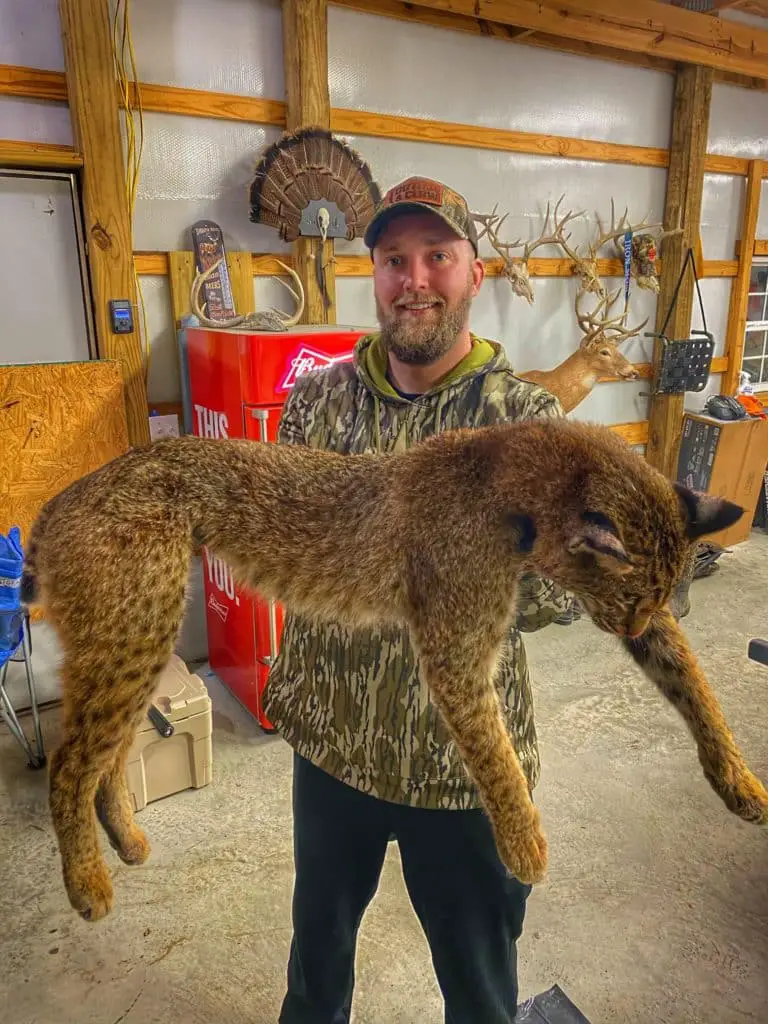
You can sit while bobcat hunting in more open terrain, and if you have a tree stand, you’re golden. Elevation is always a benefit when predator hunting.
Find the high ground and use it wherever you can. A small hill or rise in the land can give you a much better view of any bobcat low crawling its way toward you.
The jury is still out on the reaction a bobcat will have upon detecting your scent. However, while it’s true bobcats have a poor sense of smell, hunting with the wind in your face will at least keep all the responding coyotes from detecting you (more on this later).
Bobcat hunting decoys.
While there are some great professional quality decoys on the market, you can get creative and save a few bucks with some homemade lures that are just as effective. For example, a feather or bit of fur hanging by a thread on a branch, a shiny bit of foil, or aluminum can top twirling a few feet above the ground works just as well. An old wriggling dog toy or battery-operated garden decoration (see below) can also be an effective lure and a distraction.
Please note: If you make a purchase from a link I provide, I receive a small commission at no extra charge to you. Thanks!
Stillness and quiet are your only bobcat hunting partners.
Well, you can certainly bring a friend, but both of you will have to be as still and quiet as possible.
Sit completely still. Avoid even moving your head, letting only your eye muscles get any kind of work.
Any time you move, your increase the likelihood of being noticed. Bobcats are the most suspicious predators on the planet. If they catch you scratching your face or fiddling with your gear, they will slip away unseen.
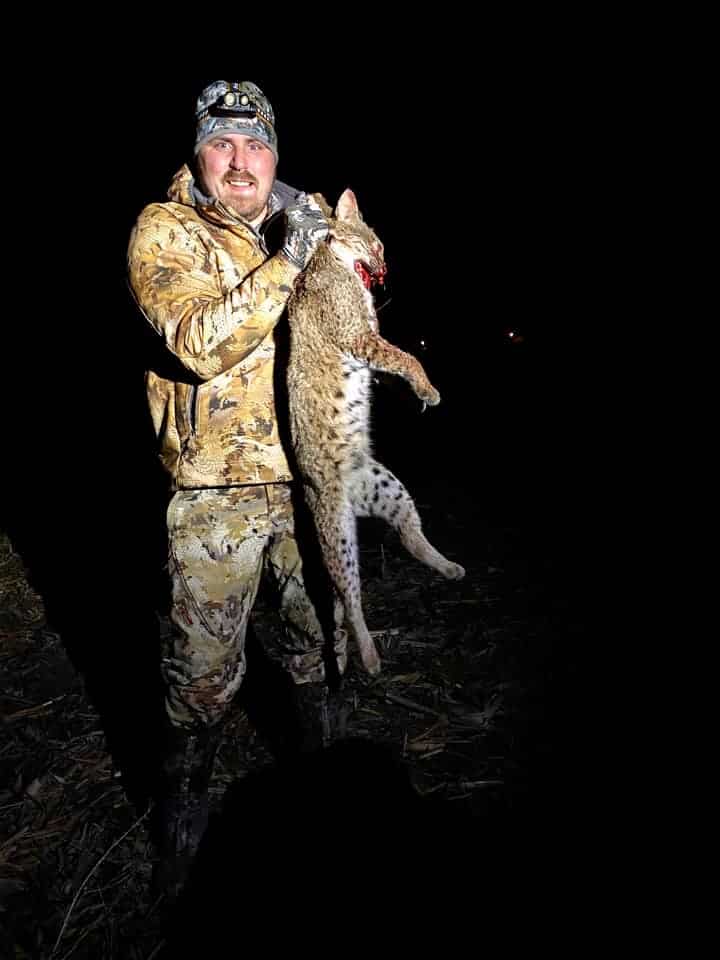
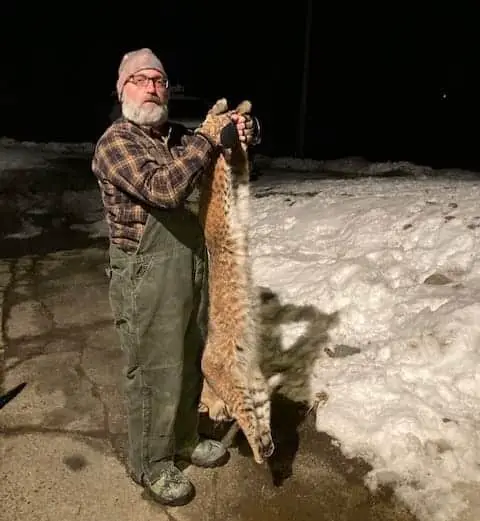
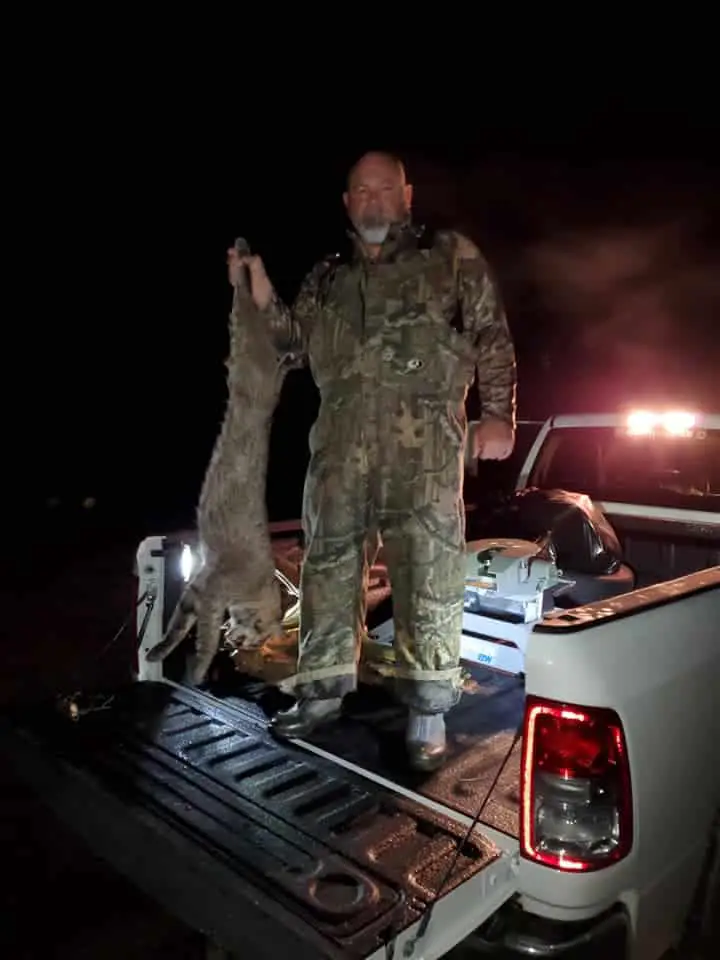
Therefore, every change of body position should be made as slowly and smoothly as possible. Be especially cautious when working with your caller. Electronic callers are best when hunting bobcats.
Expect any bobcat approaching your caller and decoy to do so by stalking. Stalking means creeping and crawling forward while completely concealed by cover. Stalking also involves extended periods of motionless study as the bobcat sits and studies everything in and around your decoy and caller.
A stalking bobcat is going to notice every move you make.
While it’s okay to make your way to your stand quickly (you can’t avoid being seen anyway), do so as quietly as possible. Start by parking your car and slowly closing the door. From now until you reopen that door to leave, no one speaks.
Bobcat hunting pro tip:
Move only your eyes and never open your mouth.
Step # 3: Calls and sequences to use while hunting bobcats.
The best time to call when bobcat hunting? Well…
The experts all disagree. Some prefer to hunt with the first light of day breaking over their stands. Others swear by hunting just before sunset. Me? I’ve killed bobcats at 2 p.m., 12:30 a.m., and just before sunrise.
Look, there may be a bobcat nap time (somewhere between 10 and 2 p.m.), but other than that, they always seem to be willing to come to a good call.
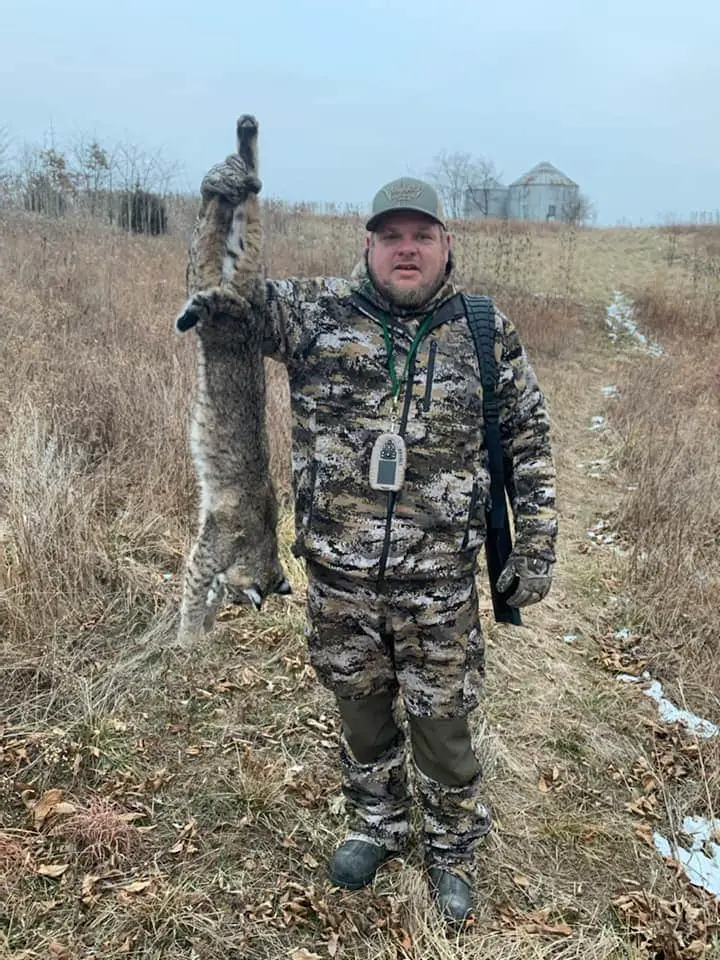
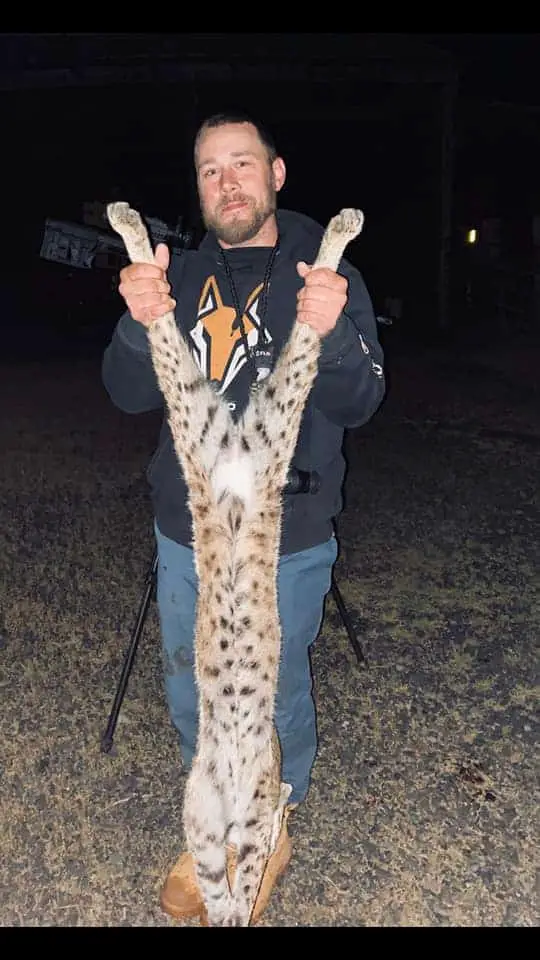
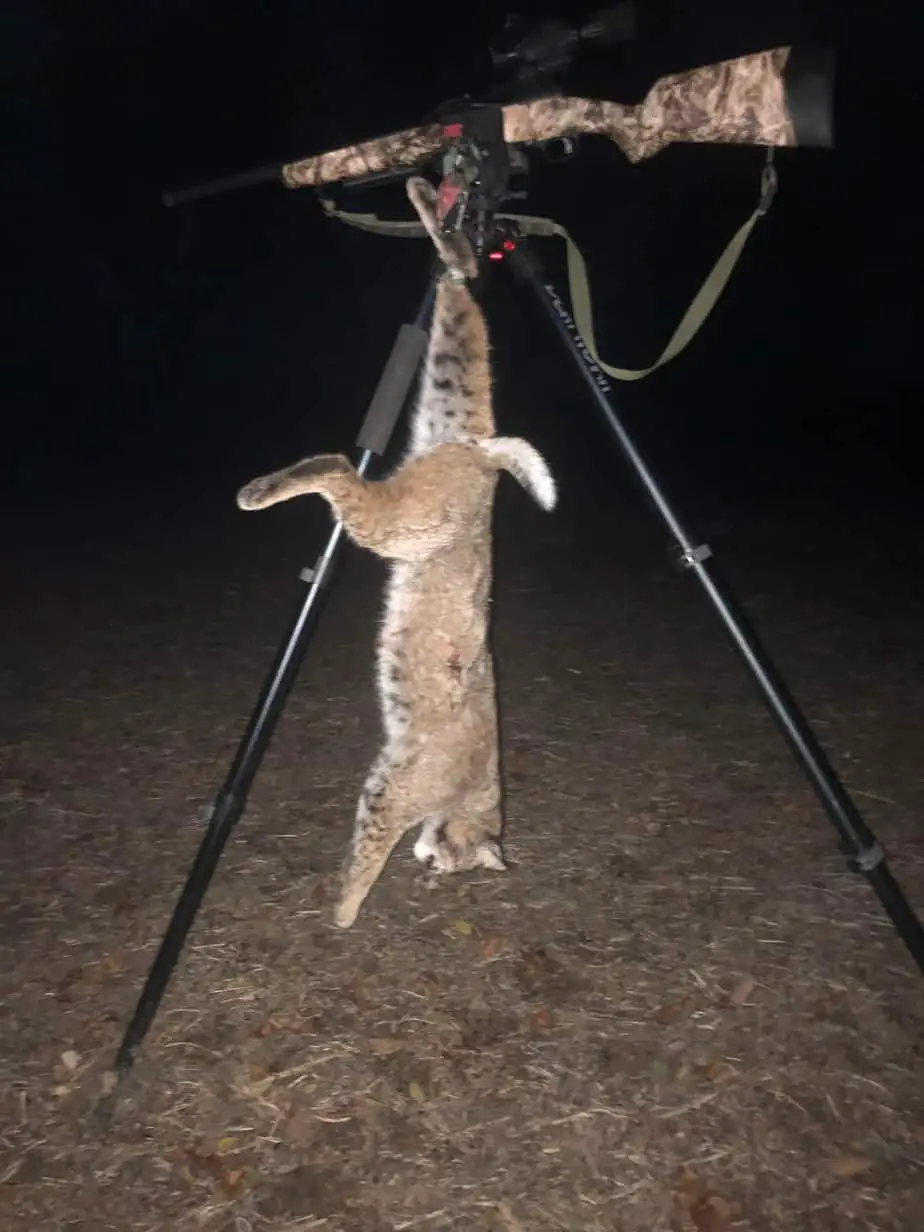
Kevin Schaefer tells us, “We sat in a deer blind, called for one minute using baby cottontail, and this bobcat showed up at 20 yards.”
Ryan Owen, calling bobcat for the first time this year, explained, “I sure love doing it. I missed several times, at first. That adrenaline rush when you have three coyotes coming at the same time!”
When calling bobcats, keep your volume low, and your sounds realistic..
In real life, an animal shrieking in distress is either dead in seconds or shuts up within a minute. When you call, try to mimic what happens in nature.
Begin your call at a very low volume. With the caller 25 yards away, you should just be able to hear it for the first two or three sequences. Call for half a minute, go quiet for two minutes, and repeat. After a few cycles, it’s fine to begin raising the volume but never go past the halfway point of your volume’s control knob.
If you have hunted coyotes before, you know the dogs can come within seconds of hearing a call. Bobcats, on the other hand, love to take their sweet time. Sure, one may surprise you and come roaring in, but, Nah, that won’t happen for you.
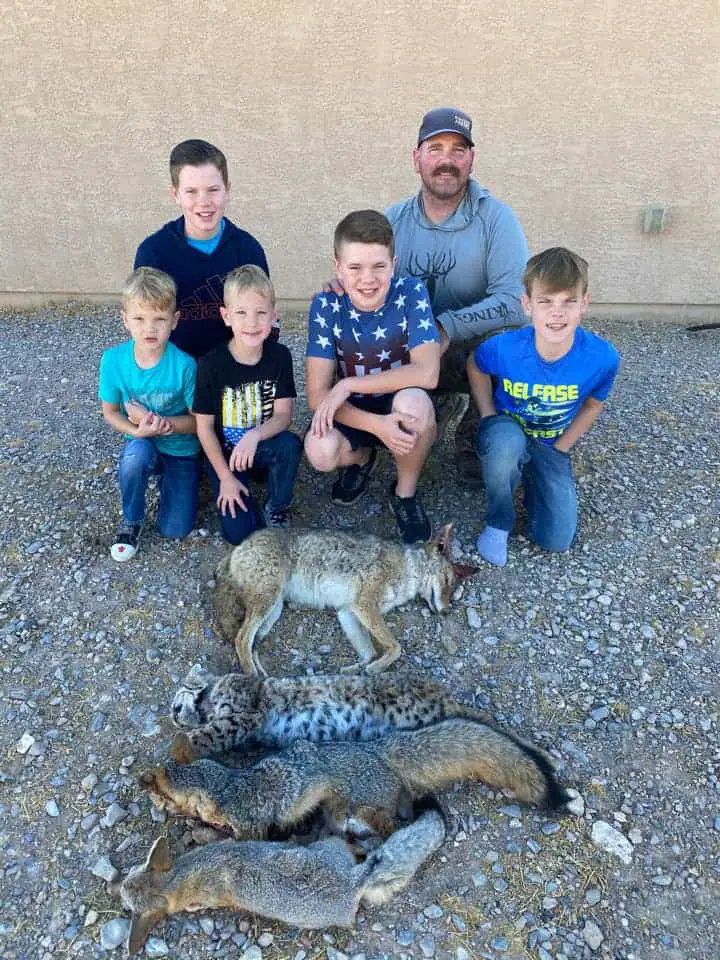
Predator hunting is a family affair for the Staley boys.
Related: Hunting-eastern-coyotes-how-to-become-a-giant-killer/
Calling bobcats using nonstop or intermittent sequences.
What about nonstop calling?
There is a school of thought that says pauses give bobcats too much time to think. The proponents of continuous calls suggest this creates a constant sense of urgency in the cat and keeps it moving forward. Only one question, how do you get a stopped bobcat to start moving again if you never stopped calling?
Hey, some things you just have to try out yourself. If you’re using an electronic caller, it’s possible to call for an unlimited time. However, if you are using mouth calls, you’ll need and should use the breaks to maintain a quality sound.
Bobcat hunting pro tip:
This inexplicable need to patrol a regular route is one of the best tips I can give you. Where there is a sign, there is a bobcat. Where there was a bobcat, there will be a bobcat.
For me, the three bobcats I mutilated beyond recognition all died with 200 yards of each other over a three-year period. And, while I have no proof, I have come to believe every deceased bobcat I shot has his territory and his exact route taken over by its successor.
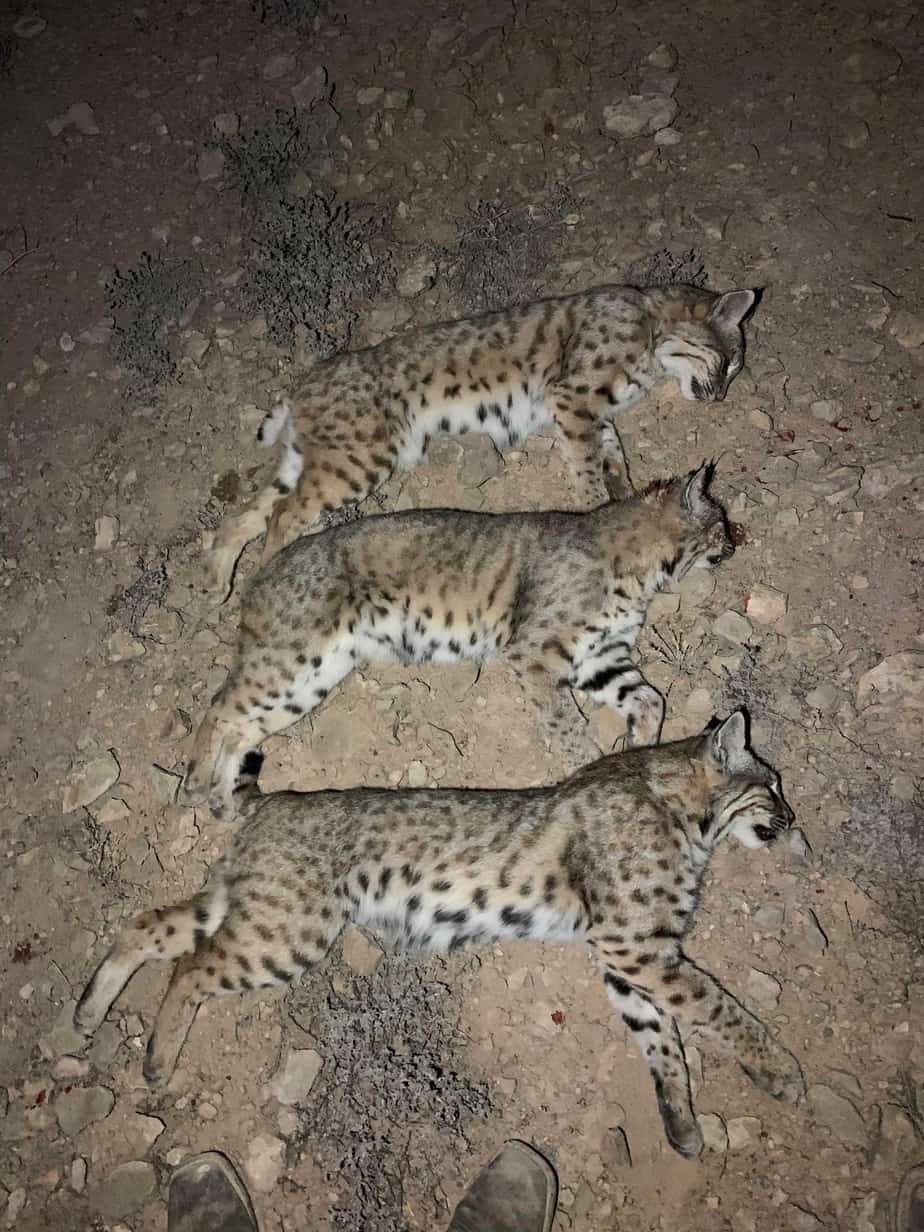
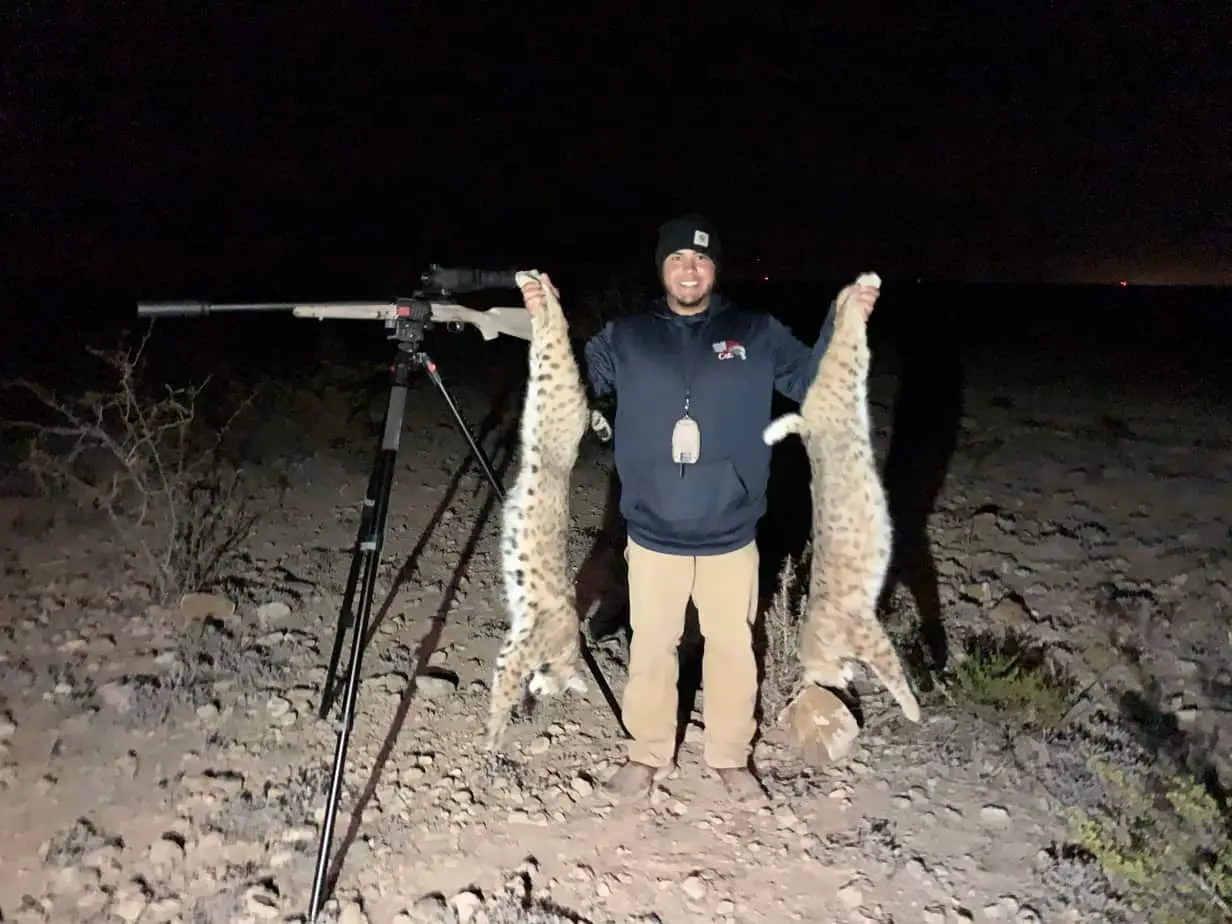
Oscar Sanchez offers us his secret tool list, the same one he used to lure in three bobcats to the same stand. All died within 10-15 minutes of each other. That’s a record few will every equal, let alone beat!
“I use a Savage 12 FV 22-250 rifle, a Dead Air Nomad 30 suppressor, a Pulsar Trail XQ38 LRF Thermal, a Lucky Duck Revolt E-Caller, and a Bog-Pod Deathgrip tripod.”
Need a night scope?
What are the best night scopes for beginners?
I recommend and use the ATN Infrared and ATN Thermal scopes. I recommend purchasing through Amazon.com and buying the accident policy—you’ll be traveling in the dark across uneven terrain.
I seriously recommend you choose the lower scope magnification. A larger field of view is more suited to the shorter ranges you’ll encounter while a new predator hunter.
When you hunt bobcats, extend your calling time.
Call for more than 30 minutes.
Wait, that’s not realistic, is it? What animal moans and cries for half an hour? Ah, here’s where you have to think like a rabbit, say, and not a bobcat. Rabbits and squirrels die horrible deaths outside of a predator’s mouth too. And rabbits caught on barb wire or stuck in a fence can go on all night long.
Bobcat calling sounds.
Female bobcat in heat.
Here’s where the male bobcat might be willing to speed up his appearance. Sensing a chance to mate, the male may come charging straight in. The downside? Well, it sounds like a human female screaming, and enough of it in the wrong place might bring you some human attention.
Deer in distress.
Deer may be on the menu, but live deer are targeted mostly by male bobcats during the winter. Therefore, in the option of the most successful bobcat hunters, avoid using a deer in distress call. If you opt to try a deer call, stick to a fawn in distress and use it all year long.

Cottontail in distress.
The rabbit brought you here; the rabbit usually brings the bobcat too. The only caveat, don’t switch sounds once you start. For example, it may be more enjoyable for you to play a baby cottontail and then switch to snowshoe hare, but it could raise some alarms in the cat’s mind. But, hey, if staying motionless for half the night and listening to the sound of a dying rabbit is too much, try another rabbit sound. But please, don’t switch species during a stand. You jump from cottontail to turkey at your peril.
Birds in distress.
Blue jays, nutty nuthatch, it doesn’t matter. The two nice things about birds sounds are the chance to get away from screaming rabbit (a sound used by police to end standoffs!) for a while, and so you can honestly plead not guilty to paying $299 for one sound.
Bobcat hunting pro tip:
The bird you use doesn’t even have to live within 1,000 miles of where you are calling.
Try a yellow-billed magpie ( strictly a California resident in NY). You’ll find it on the ihunt by Ruger (750 calls for $60 at the time of this writing).
Patience is a virtue when bobcat hunting.
That long, motionless stand is only part of the testing of your patience. The torturing of it will begin the moment you lay eyes on Mr. Tom. If you catch him stalking in, you’ll never spend more time waiting for an animal to offer you the perfect shot.
Bobcats make slow stalks, but bobcats close to a caller or within sight of a decoy act like spaceships on the edge of a black hole. Their movement is imperceptibly slow.
Bobcats are ambush predators.
The target they will initially present will be one of both cover (an impenetrable object blocking your shot) and concealment. An ear floating over a rock. A single foreleg stretched out past a tree truncated. When they are broadside to you, it will be a questionable target with a mass of twisted branches and twigs masking it.
A minute can feel like an hour when you’re holding a shotgun up. And a bobcat is sometimes willing to sit down and wait an hour before taking its next step. If you aren’t careful, you’ll start breathing heavy and raising and lowering that weapon like a mime screwing around in a weightlifting gym.
Get ready for the strike!
Just when you think you have him, when just one more step has him standing dead center of your site, he’ll go from 0-30 mph, take a swipe at your decoy, and exit the area posthaste. So, what I’m really saying is, be prepared to shoot, but not too prepared. No, wait. I’m mean, don’t be too prepared but…
Um, expect the unexpected? Yeah, let’s go with that.
Author’s note: The above confusing writing is due to my experience. Not a single bobcat I have ever taken has even been in a condition to photograph, let alone bring home. Hey, they pop up out of nowhere 16 feet in front of you, and your 12 gauge hevi shot takes the entire head off. Seriously, you will have to be a better shot than I am, or you won’t bring enough home to prove you even saw a bobcat.
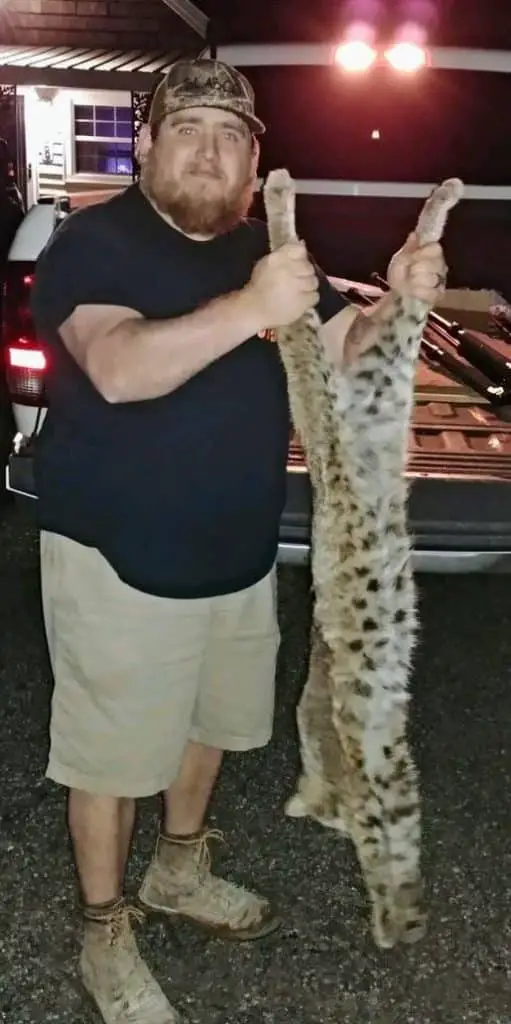
Bobcat hunting Pro tip: It’s easy to forget this, especially if you’re a brand new bobcat hunter, but always ask the bobcat to stop before you pull the trigger. As soon as the bobcat is within range and in your sights, lip squeak. Like every other predator, that sudden harmless, vaguely prey-like sound instantly halts a bobcat in its tracks and makes its head and eyes swivel in your direction.
How weather plays a part when hunting bobcats.
In general, a light dusting of snow is a blessing as it provides the freshest, easiest recognizable sign that proves recent bobcat activity in your hunting area.
Bobcats will travel nearly unaffected by light rain and snow. While traveling over medium snow accumulation, bobcats will make greater use of animal trails and terrain features like logs. In deep powdery or soft snow, bobcats prefer to travel more frequently using plowed roads and snowmobile trails.
During heavy rain or snowstorms, bobcats will take shelter from the elements—wind-sheltered areas such as thick brush, fallen logs, and tree stumps.
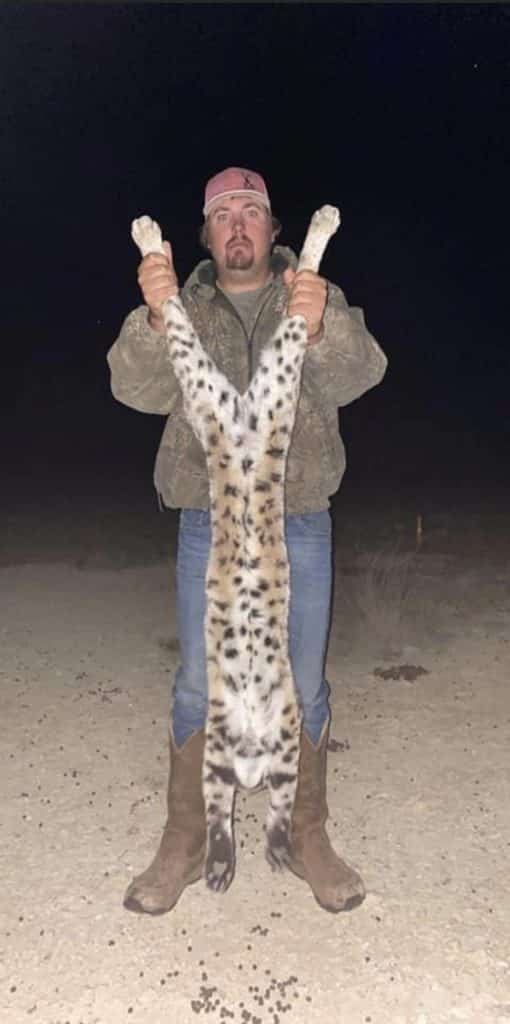
Jeffrey Williams took this 28 lbs. 28 lb male, Texas bobcat using a Ruger American Ranch 6.5 grundel. He called using Nutty nuthatch, and lured the cat to within 75 yards after only five minutes of calling.
Related: The-truth-about-predator-hunting-in-bad-weather/
Carry a rifle and a shotgun when you hunt bobcats.
I left this for last, remember I’m the one who ruins pelts. Fortunately, we have a host of successful hunters who offered their advice. The 22-250 (I have never actually fired this caliber) seems to get a lot of love. The 12 gauge with Hevi Shot dead coyote is another popular choice (the projectiles are also frangible, meaning there is less ricochet potential).
One thing you’ll notice with the calibers used? They all work just as well on coyotes. And trust me, if you are in good bobcat habitat, you’re going to bring in more coyotes than cats. If you’re in the eastern United States, you’ll call in dozens of coyotes before you see a single bobcat. That fact alone dictates you carry a rifle suitable to take a much heavier coyote.
Thinking about hunting eastern coyotes or red and gray fox? Check out my books!
Remember the 3 steps when you head out to hunt bobcats.
First, I wish you good luck and straight-shooting.
And Hurry up, before Don Ressler gets them all!
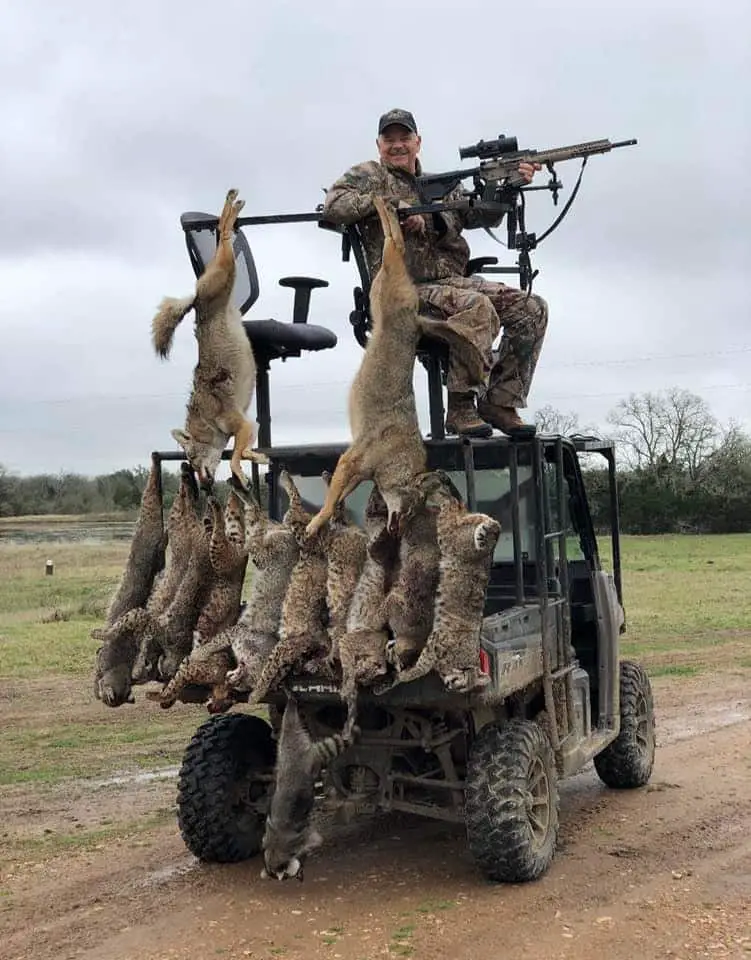
Bobcat hunting is one of the most challenging forms of predator hunting. To be successful, remember your tips: scout, set up your stand so that you have good visibility and cover, and call naturally. With enough great stand locations and a dose of persistence, you’ll soon bring home that most elusive predator, the bobcat. Good Luck!

